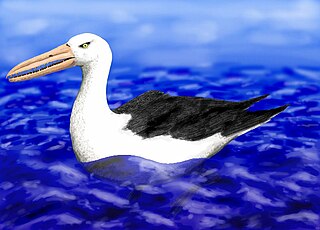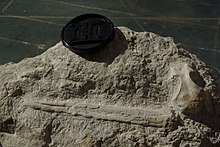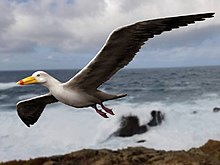
Anseriformes is an order of birds also known as waterfowl that comprises about 180 living species of birds in three families: Anhimidae, Anseranatidae, and Anatidae, the largest family, which includes over 170 species of waterfowl, among them the ducks, geese, and swans. Most modern species in the order are highly adapted for an aquatic existence at the water surface. With the exception of screamers, males have penises, a trait that has been lost in the Neoaves. Due to their aquatic nature, most species are web-footed.

Traditionally, the bird order Apodiformes contained three living families: the swifts (Apodidae), the treeswifts (Hemiprocnidae), and the hummingbirds (Trochilidae). In the Sibley-Ahlquist taxonomy, this order is raised to a superorder Apodimorphae in which hummingbirds are separated as a new order, Trochiliformes. With nearly 450 species identified to date, they are the most diverse order of birds after the passerines.

The mousebirds are birds in the order Coliiformes. They are the sister group to the clade Cavitaves, which includes the Leptosomiformes, Trogoniformes (trogons), Bucerotiformes, Piciformes and Coraciformes. This group is now confined to sub-Saharan Africa, and it is the only bird order confined entirely to that continent, with the possible exception of turacos which are considered by some as the distinct order Musophagiformes, and the cuckoo roller, which is the only member of the order Leptosomiformes, and which is found in Madagascar but not mainland Africa. Mousebirds had a wider range in the Paleogene, with a widespread distribution in Europe and North America during the Paleocene.

Osteodontornis is an extinct seabird genus. It contains a single named species, Osteodontornis orri, which was described quite exactly one century after the first species of the Pelagornithidae was. O. orri was named after Santa Barbara Museum of Natural History paleontologist Phil C. Orr, for his recognition of the importance of the specimen.

Presbyornis is an extinct genus of anseriform bird. It contains two unequivocally accepted species; the well-known P. pervetus and the much lesser-known P. isoni. P. pervetus was approximately the size and shape of a goose, but with longer legs; P. isoni, known from a few bones, was much larger, more than swan-sized. Other fossils, more doubtfully assigned to this genus, are also known.
Paraptenodytes brodkorbi is a proposed, but possibly invalid, species of extinct penguin in the genus Paraptenodytes. The bird was probably about the size of a king penguin. Known material is limited to a single humerus, Early Miocene in age, found in the Monte León Formation near Puerto San Julián in Santa Cruz Province, Argentina. It exists as an unnumbered specimen in the collection of the Museo Argentino de Ciencias Naturales.

The Pelagornithidae, commonly called pelagornithids, pseudodontorns, bony-toothed birds, false-toothed birds or pseudotooth birds, are a prehistoric family of large seabirds. Their fossil remains have been found all over the world in rocks dating between the Early Paleocene and the Pliocene-Pleistocene boundary.
Caspiodontornis is a genus of the prehistoric pseudotooth birds of somewhat doubtful validity. These were probably rather close relatives of either pelicans and storks, or of waterfowl, and are here placed in the order Odontopterygiformes to account for this uncertainty.
Cyphornis is a genus of the prehistoric pseudotooth birds. These were probably rather close relatives of either pelicans and storks, or of waterfowl, and are here placed in the order Odontopterygiformes to account for this uncertainty.

Dasornis is a genus of prehistoric pseudotooth birds. These were probably close relatives of either pelicans and storks or waterfowl; they are placed in the order Odontopterygiformes to account for this uncertainty.
Gigantornis eaglesomei is a very large prehistoric bird described from a fragmentary specimen from the Eocene of Nigeria. It was originally described as a representative of the albatross family, Diomedeidae, but was later referred to the pseudotooth or bony-toothed bird family, Pelagornithidae. Gigantornis is one of the largest pseudotooth birds, with an inferred wingspan of about 6 m (20 ft) it is among the largest birds ever.
Palaeochenoides is a genus of the prehistoric pseudotooth birds of somewhat doubtful validity. These were probably rather close relatives of either pelicans and storks, or of waterfowl, and are here placed in the order Odontopterygiformes to account for this uncertainty.

Pelagornis is a widespread genus of prehistoric pseudotooth birds. These were probably rather close relatives of either pelicans and storks, or waterfowl, and are placed here in the order Odontopterygiformes to account for this uncertainty.
Pseudodontornis is a rather disputed genus of the prehistoric pseudotooth birds. The pseudotooth birds or pelagornithids were probably rather close relatives of either pelicans and storks, or of waterfowl, and are here placed in the order Odontopterygiformes to account for this uncertainty. Up to five species are commonly recognized in this genus.
Tympanonesiotes is a somewhat doubtfully valid genus of the prehistoric pseudotooth birds. These were probably rather close relatives of either pelicans and storks, or of waterfowl, and are here placed in the order Odontopterygiformes to account for this uncertainty.
Macrodontopteryx is a genus of the prehistoric pseudotooth birds of somewhat doubtful validity. These animals were probably rather close relatives of either pelicans and storks, or of waterfowl, and are here placed in the order Odontopterygiformes to account for this uncertainty.

Lithornis is a genus of extinct paleognathous birds. Although Lithornis was able to fly well, their closest relatives are the extant tinamous and ratites.
Eostrix is a genus of extinct primitive owls in the family Protostrigidae, along with Oligostrix and Minerva. These owls date from the early Eocene of the United States, Europe, and Mongolia. They have been described based on fossil remains. The genus was created by Pierce Brodkorb in 1971 to place a fossil species known until that time as Protostrix mimica.
Pulchrapollia is an extinct genus of halcyornithid bird from the Early Eocene London Clay of Walton-on-the-Naze, United Kingdom and the Nanjemoy Formation of Virginia, United States. The genus contains three species, Pulchrapollia gracilis, Pulchrapollia tenuipes and Pulchrapollia eximia.



















